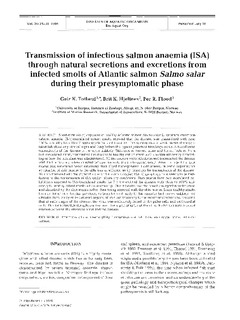| dc.contributor.author | Totland, Geir K. | |
| dc.contributor.author | Hjeltnes, Brit K. | |
| dc.contributor.author | Flood, Per R. | |
| dc.date.accessioned | 2007-06-20T08:41:00Z | |
| dc.date.issued | 1996-07-18 | |
| dc.identifier.issn | 0177-5103 | |
| dc.identifier.uri | http://hdl.handle.net/11250/108667 | |
| dc.description.abstract | Short-term (48 h) exposure of healthy Atlantic salmon Salmo salar L. smelts to infectious salmon anemia (ISA)-inoculated cohort smelts showed that the disease was transmitted with near 100% mortality from Day 7 post-inoculation and onwards. This is more than a week before the inoculated fish show any clinical signs and long before the typical petechial bleedings occur. A bloodborne transmission of the disease is therefore unlikely. Skin mucus, faeces, urine and blood, isolated from ISA-inoculated smelt, transmitted the disease to healthy cohort smelt with variable efficiency depending on how the inoculum was administered. All the sources were infectious and transmitted the disease with high efficiency when injected intraperitoneally (i.p.) into cohort smelt. After i.p. injection, skin mucus had somewhat lower infectivity than blood homogenates. Furthermore, in some experiments application of skin mucus to the gills was as efficient as i.p. injection for transmission of the disease. When introduced into the stomach none of the inocula caused ISA. Coprophagy thus seems to be ineffective in the transmission of TSA under laboratory conditions. Skin mucus from non-inoculated cohabitants exposed to ISA-inoculated smelts for 2 d transmitted the disease with close to 100% efficiency to healthy cohort smelts when injected i.p. This indicates that the infectious agent is waterborne and absorbed by the skin mucus rather than being secreted with the skin mucus. Since healthy smelts have an intact skin barrier, proximity to inoculation directly to the vascular bed seems unlikely. An ultrastructural study of 10 different organs, all in close proximity to the secretions/excretions, revealed that at early stages of the disease, the virus was exclusively found in the pillar cells and endocardial cells. This indicates that the gills are the most Likely port of entry of the virus. It also supports a causal relation between the observed virus and the disease. | en |
| dc.format.extent | 1499491 bytes | |
| dc.format.mimetype | application/pdf | |
| dc.language.iso | eng | en |
| dc.subject | infectious salmon anaemia (ISA) | en |
| dc.subject | infeksiøs lakseanemi (ILA) | en |
| dc.subject | salmon | en |
| dc.subject | laks | en |
| dc.subject | fish diseases | en |
| dc.subject | fiskesykdommer | |
| dc.title | Transmission of infectious salmon anaemia (ISA) through natural secretions and excretions from infected smolts of Atlantic salmon Salmo salar during their presymptomatic phase | en |
| dc.type | Journal article | en |
| dc.type | Peer reviewed | |
| dc.source.pagenumber | 25-31 | en |
| dc.source.volume | 26 | |
| dc.source.journal | Diseases of Aquatic Organisms | |
| dc.source.issue | 1 | |
| dc.identifier.doi | http://dx.doi.org/10.3354/dao026025 | |
